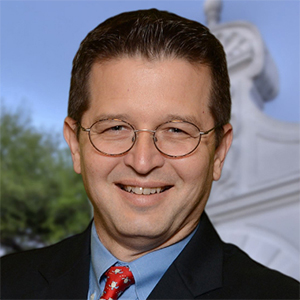Author Clay Henderson on the History of Eco-Advocacy in Florida
In keeping with its tradition of bringing Florida’s best-known environmentalists to campus for enlightening conversations, the first Foreman Biodiversity Lecture of the Fall 2023 semester featured pioneering environmental lawyer Clay Henderson.
On the heels of his 2022 book, Forces of Nature: A History of Florida Land Conservation, Henderson has been touring the state to talk about a cause about which he is most passionate: public policy’s critical role in protecting Florida’s vulnerable natural ecosystems.
Over the decades, Henderson has held various influential positions. He served on the Florida Constitution Revision Commission, the Florida Community Trust, and the Volusia County Council, on which he was elected to serve two terms. An early advocate for land conservation, he has been recognized with multiple awards, including the Nature Conservancy’s National Public Service Award and the Marine Resources Council Florida Trust’s Lifetime Achievement Award.
Thinking differently about environmental regulation
Henderson said he considers the genesis of modern environmental regulation in Florida to be the Land and Water Conservation Act of 1971. Advocating for policies that were effective in protecting critical natural lands from overdevelopment – ones developers could not easily outmaneuver – required a lot of trial and error – and a lot of improvisation, he said.
We didn’t know what we were doing,” Henderson said of the early years. “We had to make up the rules, make up the procedures, however we were going to do it. So, when the state started embarking on these larger, billion-dollar efforts, (it was) the same thing, we kind of had to make it up along the way.”
One innovative approach that proved effective was using public funds to buy up private land that would be preserved and protected in perpetuity.
“What was critical at the very beginning of Florida’s environmental movement was this recognition… that, if you’re going to regulate people, the concern was that you’re going to take their property,” Henderson said. “Therefore, we needed to have some funds available – so if you really want to conserve that person’s land, you don’t take it, you buy it.”
Inspired by history
For more than a century, advocates for protecting Florida’s natural spaces and the wildlife that inhabits them have included prominent lawyers, writers, and even a president – something Henderson’s book thoughtfully examines.
Among the earliest champions for Florida’s wildlife and their habitat was President Theodore Roosevelt, who, prior to the Spanish-American War (and thus his presidency) visited the Sunshine State as a birder. He was reportedly devastated upon seeing mounds and mounds of dead birds on Florida’s docks being prepared for shipment to New York, where their feathers would be turned into ladies’ hats.
It is estimated that as much as 95 percent of Florida’s wading birds were killed for this purpose at the time, Henderson said.
Years later, as president, Roosevelt signed 10 executive orders conserving over one million acres in Florida, starting with Pelican Island National Wildlife Refuge.
At the state level, Florida established its first park, Royal Park Hammock State Park, in 1915; it is now part of Everglades National Park.
Another famous advocate, Marjorie Harris Carr, fought against construction of the Cross Florida Barge Canal – a centuries-old idea for bisecting the state via an artificial east-to-west canal, which critics derided as a boondoggle that would be detrimental to surrounding ecosystems. The project was ultimately abandoned and its intended area became the Marjorie Harris Carr Cross Florida Greenway.
Henderson offered a litany of more recent examples of meaningful land protections in Florida, including Amendment 1 (supported land-acquisition supported by the document stamp tax, which voters overwhelmingly passed in 2014), the successful completion of the Florida Wildlife Corridor, and the popular Florida Forever program.
Deep Stetson ties
 Law Professor Royal Gardner
Law Professor Royal Gardner
Though his work sees national recognition, Henderson has long been a member of the Stetson community.
He was the inaugural director of the Institute for Water and Environmental Resilience at Stetson’s main campus in DeLand. He would go on to teach water law courses at the College of Law.
Law Professor Royal Gardner, directorof Stetson’s Institute for Biodiversity Law and Policy, said he hopes stories like Henderson’s will inspire nascent legal professionals to consider running for office.
“Government service is so important, and we need good people to run for office. So, follow his example, please,” Gardner said. “Think about that. It’s a hard ask, but we need good people running for office.”

